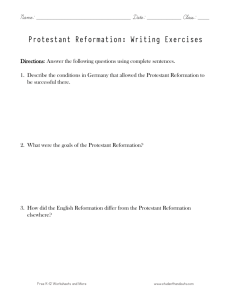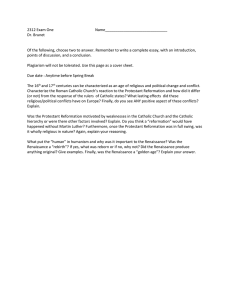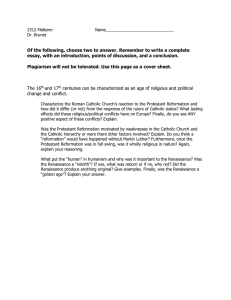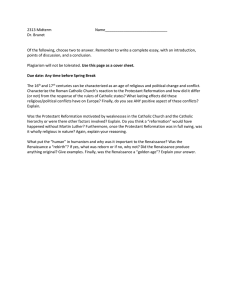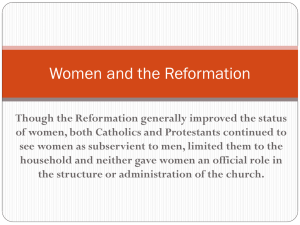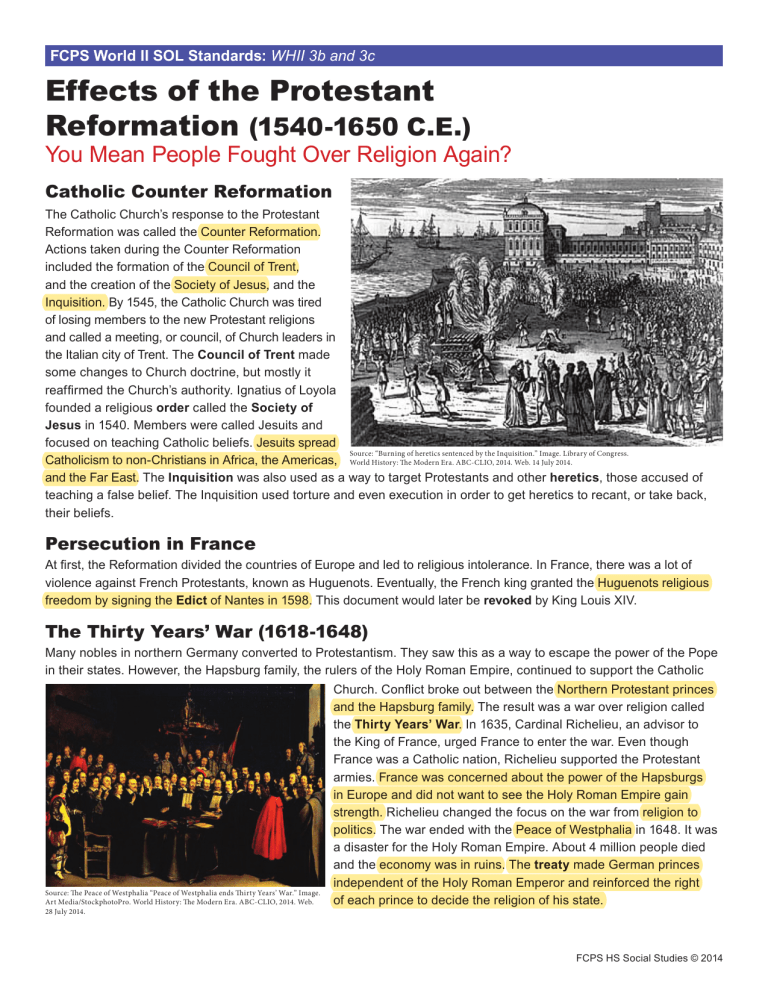
FCPS World II SOL Standards: WHII 3b and 3c
Effects of the Protestant
Reformation (1540-1650 C.E.)
You Mean People Fought Over Religion Again?
Catholic Counter Reformation
The Catholic Church’s response to the Protestant
Reformation was called the Counter Reformation.
Actions taken during the Counter Reformation
included the formation of the Council of Trent,
and the creation of the Society of Jesus, and the
Inquisition. By 1545, the Catholic Church was tired
of losing members to the new Protestant religions
and called a meeting, or council, of Church leaders in
the Italian city of Trent. The Council of Trent made
some changes to Church doctrine, but mostly it
reaffirmed the Church’s authority. Ignatius of Loyola
founded a religious order called the Society of
Jesus in 1540. Members were called Jesuits and
focused on teaching Catholic beliefs. Jesuits spread
Source: “Burning of heretics sentenced by the Inquisition.” Image. Library of Congress.
Catholicism to non-Christians in Africa, the Americas, World History: The Modern Era. ABC-CLIO, 2014. Web. 14 July 2014.
and the Far East. The Inquisition was also used as a way to target Protestants and other heretics, those accused of
teaching a false belief. The Inquisition used torture and even execution in order to get heretics to recant, or take back,
their beliefs.
Persecution in France
At first, the Reformation divided the countries of Europe and led to religious intolerance. In France, there was a lot of
violence against French Protestants, known as Huguenots. Eventually, the French king granted the Huguenots religious
freedom by signing the Edict of Nantes in 1598. This document would later be revoked by King Louis XIV.
The Thirty Years’ War (1618-1648)
Many nobles in northern Germany converted to Protestantism. They saw this as a way to escape the power of the Pope
in their states. However, the Hapsburg family, the rulers of the Holy Roman Empire, continued to support the Catholic
Source: The Peace of Westphalia “Peace of Westphalia ends Thirty Years’ War.” Image.
Art Media/StockphotoPro. World History: The Modern Era. ABC-CLIO, 2014. Web.
28 July 2014.
Church. Conflict broke out between the Northern Protestant princes
and the Hapsburg family. The result was a war over religion called
the Thirty Years’ War. In 1635, Cardinal Richelieu, an advisor to
the King of France, urged France to enter the war. Even though
France was a Catholic nation, Richelieu supported the Protestant
armies. France was concerned about the power of the Hapsburgs
in Europe and did not want to see the Holy Roman Empire gain
strength. Richelieu changed the focus on the war from religion to
politics. The war ended with the Peace of Westphalia in 1648. It was
a disaster for the Holy Roman Empire. About 4 million people died
and the economy was in ruins. The treaty made German princes
independent of the Holy Roman Emperor and reinforced the right
of each prince to decide the religion of his state.
FCPS HS Social Studies © 2014
Effects of Protestant Reformation (cont.) WHII 3b and 3c
Social Changes
The Protestant Reformation resulted in religious changes but also social changes.
People questioned the authority of the Roman Catholic Church, and as a result,
secularism increased. New Protestant religions focused on an individual’s ability
to read and interpret scripture without guidance from the Church. During this time,
literacy increased mainly because of Gutenberg’s invention of the printing press in the
1450’s. The Bible was printed in English, French, and German. This meant people
could read the Bible on their own. As a result, individualism also increased. Another
social change was a gradual increase in religious tolerance.
Europe during the Reformation Control. Catholic leaders in green; Protestants in blue; Eastern Orthodox Church in gray and Muslims in red.
Source: http://en.wikipedia.org/wiki/Protestantism_and_Islam
Key Vocabulary
Council of Trent: meeting in 1545 of Roman
Catholic Church leaders to address the
concerns of the Protestants
Order: a religious organization whose
members usually live together and promise
to follow special rules and traditions
Society of Jesus/Jesuits: Catholic religious
group dedicated to teaching Catholic beliefs
and spreading the religion
Inquisition: a papal judicial process established
to try and punish those thought to be heretics
Edict: a law
Heretics: someone who believes or teaches
something that goes against accepted or
official beliefs
Revoke: to take back, withdraw
Treaty: an agreement between nations
Thirty Years’ War: religious war in central
Europe between Catholics and Protestants
Secularism: non-religious, focus on this world
Scripture: a religious text or teaching
Individualism: a belief that the interests of the
individual are of the greatest importance
Tolerance: acceptance of feelings, habits, or
beliefs that are different from one’s own
Quick Review
2. Which of the following was NOT an effect of the printing press?
A. Increase in literacy
B. Spreading of new ideas
such as Protestant religions
C. The Bible was printed in
English, French, and German
D. Decrease in secularism
1. What best completes the chart?
A. Protestant Reformation
B. Counter Reformation
C. Causes of the Thirty Years’ War
D. Effects of the Renaissance
3. Who were the Huguenots?
A. French Protestants
B. German Protestants
C. French Catholics
D. German Catholics
4. Identify and explain two to three examples of conflicts
caused by the Protestant Reformation.
Connection to Today
Resources
Throughout history and still to this day, religion has been a source of
many conflicts. What modern examples of religious conflict can you
think of? Why do you think people reference religion as a motive to
engage in conflict?
● FCPS Library Resource - ABC Clio: Thirty Years’ War Overview:
http://worldhistory.abc-clio.com/Topics/Display/1239496?cid=41&ter
ms=Thirty+Years%27+War
Learn 360
● Protestant Reformation
http://goo.gl/4XDjLJ
FCPS HS Social Studies © 2014


